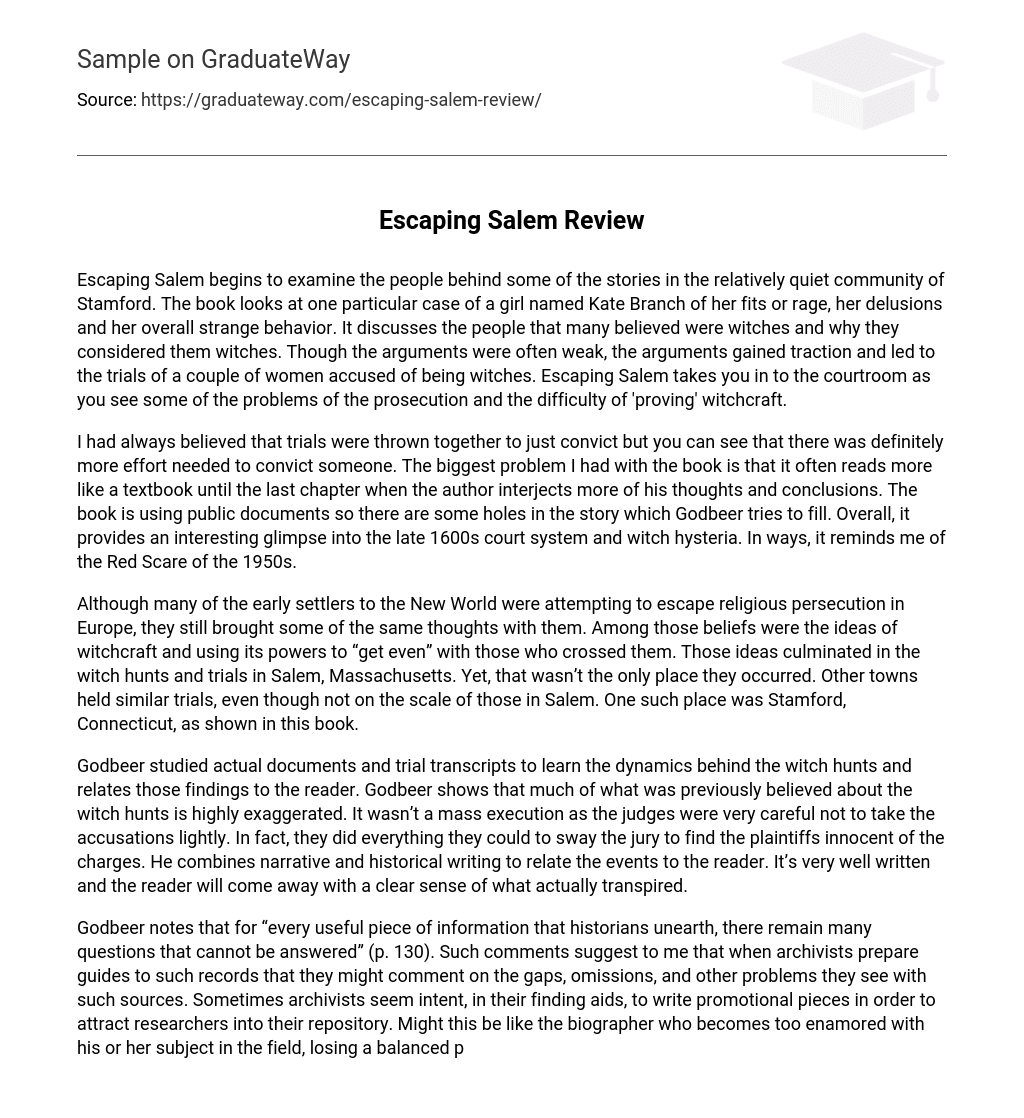Escaping Salem begins to examine the people behind some of the stories in the relatively quiet community of Stamford. The book looks at one particular case of a girl named Kate Branch of her fits or rage, her delusions and her overall strange behavior. It discusses the people that many believed were witches and why they considered them witches. Though the arguments were often weak, the arguments gained traction and led to the trials of a couple of women accused of being witches. Escaping Salem takes you in to the courtroom as you see some of the problems of the prosecution and the difficulty of ‘proving’ witchcraft.
I had always believed that trials were thrown together to just convict but you can see that there was definitely more effort needed to convict someone. The biggest problem I had with the book is that it often reads more like a textbook until the last chapter when the author interjects more of his thoughts and conclusions. The book is using public documents so there are some holes in the story which Godbeer tries to fill. Overall, it provides an interesting glimpse into the late 1600s court system and witch hysteria. In ways, it reminds me of the Red Scare of the 1950s.
Although many of the early settlers to the New World were attempting to escape religious persecution in Europe, they still brought some of the same thoughts with them. Among those beliefs were the ideas of witchcraft and using its powers to “get even” with those who crossed them. Those ideas culminated in the witch hunts and trials in Salem, Massachusetts. Yet, that wasn’t the only place they occurred. Other towns held similar trials, even though not on the scale of those in Salem. One such place was Stamford, Connecticut, as shown in this book.
Godbeer studied actual documents and trial transcripts to learn the dynamics behind the witch hunts and relates those findings to the reader. Godbeer shows that much of what was previously believed about the witch hunts is highly exaggerated. It wasn’t a mass execution as the judges were very careful not to take the accusations lightly. In fact, they did everything they could to sway the jury to find the plaintiffs innocent of the charges. He combines narrative and historical writing to relate the events to the reader. It’s very well written and the reader will come away with a clear sense of what actually transpired.
Godbeer notes that for “every useful piece of information that historians unearth, there remain many questions that cannot be answered” (p. 130). Such comments suggest to me that when archivists prepare guides to such records that they might comment on the gaps, omissions, and other problems they see with such sources. Sometimes archivists seem intent, in their finding aids, to write promotional pieces in order to attract researchers into their repository. Might this be like the biographer who becomes too enamored with his or her subject in the field, losing a balanced perspective about the individual whose life is being analyzed?
This often happens in the field ethnographers and it can contaminate the study. However daunting it may be in terms of time and energies expended, archivists when they prepare such finding aids need to be conversant with how researchers have used such records and the insights such uses offer for describing them in more effective ways. This requires that they commit some time to staying current with the scholarly and other literature on the topics represented in their institutional missions and in their holdings. This is not a new idea, but it is one that has not received as much attention as it deserves.
In Escaping Salem, Godbeer seems very good at producing a straightforward narrative of the events leading to the witch trials that take into account what people believed about the supernatural and how such belief might affect what they said or accepted as said by others. This book seems to be a model of historical prose, approachable by both scholar and a more public audience. He helps us see that these were not ignorant backward people but that the New Englanders were “clearly committed to a process of empirical verification that we might perhaps characterize as scientific supernaturalism” (p. 42).
Godbeer indicates that most historians writing about the infamous witch trials have tried to be objective, but that his “book seeks to recreate the world in which the people of Stamford and Compo lived by giving them voice, avoiding the deliberate self-distancing inherent in most scholarly analysis” (p. 143). While the accusations of children begin each episode, it is the action of the adults in the households of the afflicted and in the churches and courts that determined the experiences of each community.
Godbeer clearly relates what was at stake in episodes of witch fears. The trial of a witch involved the whole community. As neighbors served as watchers over Kate Branch they became potential court witnesses. The failure to convict and execute true witches left those who testified against an acquitted witch at risk for “terrible revenge” (p. 10). To convict an accused witch, Puritans relied not on simple accusations but “careful observation and experimentation” of claims made by the victim and by witnesses: a system that Godbeer calls “scientific supernaturalism” (p. 42).
It was the deliberate use of this traditional approach by magistrates that ultimately saved Stamford from becoming a Salem in 1692. Trials also had a political dimension as the law was sometimes at odds with community notions of guilt and of justice. Other earlier witchcraft exonerations had the angered communities convinced that the accused was in fact a witch. As those acquitted returned to their homes they met mistrust and even violence at the hands of horrified neighbors. The courts knew they had to move with certainty but also cautiously.





